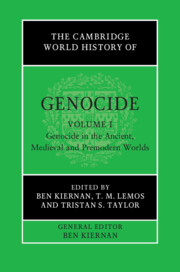Book contents
- The Cambridge World History of Genocide
- The Cambridge World History of Genocide
- The Cambridge World History of Genocide
- Copyright page
- Contents
- Figures
- Maps
- Tables
- Contributors to Volume I
- General Editor’s Acknowledgements
- General Editor’s Introduction to the Series
- Introduction to Volume I
- Part I Themes of Genocide through History
- Part II The Ancient World
- 6 Genocide in Ancient Israelite and Early Jewish Sources
- 7 Genocide in Ancient Mesopotamia during the Bronze and Iron Ages
- 8 Urbicide in the Ancient Greek World, 480–330 bce
- 9 Violence, Emotions and Justice in the Hellenistic Period
- 10 A Tale of Three Cities
- 11 Caesar’s Gallic Genocide
- 12 Genocidal Perspectives in the Roman Empire’s Approach towards the Jews
- 13 Religious Violence in the Later Roman Empire
- 14 Genocide, Extermination and Mass Killing in Chinese History
- Part III The Medieval World and Early Imperial Expansions
- Index
14 - Genocide, Extermination and Mass Killing in Chinese History
from Part II - The Ancient World
Published online by Cambridge University Press: 23 June 2023
- The Cambridge World History of Genocide
- The Cambridge World History of Genocide
- The Cambridge World History of Genocide
- Copyright page
- Contents
- Figures
- Maps
- Tables
- Contributors to Volume I
- General Editor’s Acknowledgements
- General Editor’s Introduction to the Series
- Introduction to Volume I
- Part I Themes of Genocide through History
- Part II The Ancient World
- 6 Genocide in Ancient Israelite and Early Jewish Sources
- 7 Genocide in Ancient Mesopotamia during the Bronze and Iron Ages
- 8 Urbicide in the Ancient Greek World, 480–330 bce
- 9 Violence, Emotions and Justice in the Hellenistic Period
- 10 A Tale of Three Cities
- 11 Caesar’s Gallic Genocide
- 12 Genocidal Perspectives in the Roman Empire’s Approach towards the Jews
- 13 Religious Violence in the Later Roman Empire
- 14 Genocide, Extermination and Mass Killing in Chinese History
- Part III The Medieval World and Early Imperial Expansions
- Index
Summary
This chapter examines mass killing, ‘extermination’ and ‘genocide’ in Chinese history, focusing on the Warring States period and early empires. The Chinese language contains many words for ‘attack’, ‘kill’, ‘extermination’, ‘eradication’, and ‘destruction’ of the enemy. The concept of ‘genocide’ is rendered as ‘extermination’ of an ethnic group. Mass killing was facilitated by China’s precocious development of the technology of rule, especially national conscription and centralized administration. As early as 268 BCE, the state of Qin articulated and practiced an official policy of conquest by ‘attacking not only territory but also people’ to ensure that rival states and their populations could not recover. The Western Han dynasty massacred the Xiongnu in 133-91 BCE and beyond, while the Eastern Han dynasty exterminated the Qiang in 169. Ran Min of a later divided era launched ‘execution of the Jie and extermination of their kind’ in 350. The recurrence of mass killing did not end with the fall of the last dynasty in 1911. The ‘megamurderers’ Chiang Kai-shek and Mao Zedong created ‘China’s bloody twentieth century’ by killing 10.2 million in 1921-48 and 37.8 million in 1923-76, respectively.
Keywords
- Type
- Chapter
- Information
- The Cambridge World History of Genocide , pp. 376 - 400Publisher: Cambridge University PressPrint publication year: 2023



